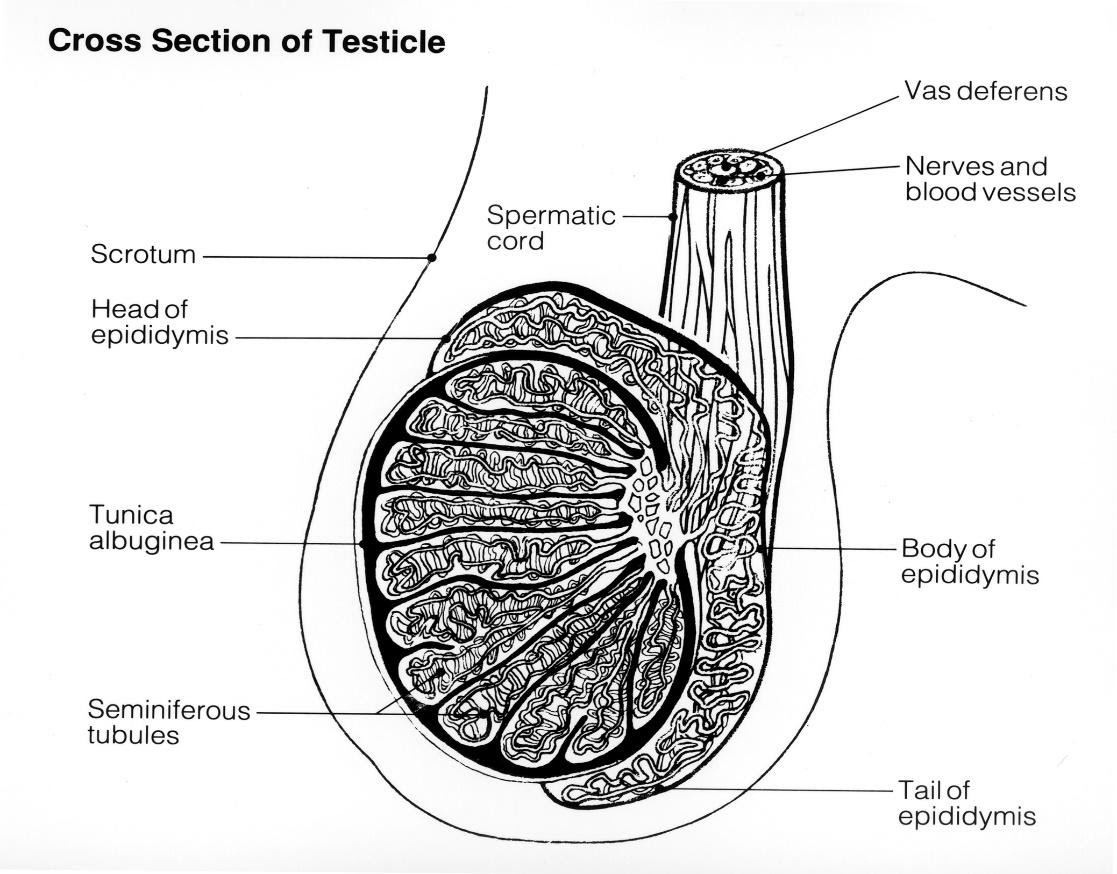
Answer
361.2k+ views
Hint: The main or major reproductive organ in men is a pair of testes. Both tests are performed in the scrotum, or scrotal sac, which is a tiny bag-like structure lying below and outside the abdominal cavity. The temperature of the scrotum is \[2 - 2.5\] degrees Celsius lower than that of the body. Flexible, elastic fibres connect each testis to the wall of the scrotal sac. Gubernaculum or Mesorchium is the name for this type of fibre. Each testis is connected to the abdominal cavity's dorsal body wall by a cord known as a spermatic cord.
Complete answer:
Internal structure of testis-
Three coats cover the testis. The tunica vaginalis is the outermost. Tunica albuginea is the middle coat, and tunica vascular is the innermost coat. Tunica vaginalis is a parietal and visceral layer of Tunica vaginalis. Except for the posterior border, where the testicular vessel and nerves enter the testis, it covers the whole testis. Tunica albuginea is a dense, fibrous white coat that covers the testes. Everywhere The tunica albuginea's posterior edge thickens to form a vertical septum known as the Mediastinum testis. Tunica vasculosa is the testis line's innermost vascular covering in testicular lobules.
The outer surface of the seminiferous tubule is made up of tunica propria, a white fibrous connective tissue, and the inner surface is made up of cuboidal germinal epithelium. The spermatogenic cells in this epithelium produce sperm through the process of spermatogenesis.
Sertoli cells have the following functions:
(1) They phagocyte damaged or dead sperm cells.
(2) They serve as the foundation for blood tests as barriers.
(3) Inhibin and anti-Mullerian hormones are produced by Sertoli cells.
(4) Sertoli cells can convert testosterone into oestrogen.
Interstitial or Leydig cells are endocrine cells that are situated between seminiferous tubules in the intratubular region. Androgen, or testosterone, is secreted by these cells.

Note:
Straight tubules, or tubule recti, are formed when seminiferous tubules connect at the lobule's apices to produce tubuli recti that enter the mediastinum. They produce a network of tubules known as the rete testis here. Vasa efferentia or ductuli efferentes are formed when the rete testis merge to generate \[10\] to \[12\] distinct efferent ductules. Each testis has approximately \[750 - 1000\] seminiferous tubules.
Complete answer:
Internal structure of testis-
Three coats cover the testis. The tunica vaginalis is the outermost. Tunica albuginea is the middle coat, and tunica vascular is the innermost coat. Tunica vaginalis is a parietal and visceral layer of Tunica vaginalis. Except for the posterior border, where the testicular vessel and nerves enter the testis, it covers the whole testis. Tunica albuginea is a dense, fibrous white coat that covers the testes. Everywhere The tunica albuginea's posterior edge thickens to form a vertical septum known as the Mediastinum testis. Tunica vasculosa is the testis line's innermost vascular covering in testicular lobules.
The outer surface of the seminiferous tubule is made up of tunica propria, a white fibrous connective tissue, and the inner surface is made up of cuboidal germinal epithelium. The spermatogenic cells in this epithelium produce sperm through the process of spermatogenesis.
Sertoli cells have the following functions:
(1) They phagocyte damaged or dead sperm cells.
(2) They serve as the foundation for blood tests as barriers.
(3) Inhibin and anti-Mullerian hormones are produced by Sertoli cells.
(4) Sertoli cells can convert testosterone into oestrogen.
Interstitial or Leydig cells are endocrine cells that are situated between seminiferous tubules in the intratubular region. Androgen, or testosterone, is secreted by these cells.

Note:
Straight tubules, or tubule recti, are formed when seminiferous tubules connect at the lobule's apices to produce tubuli recti that enter the mediastinum. They produce a network of tubules known as the rete testis here. Vasa efferentia or ductuli efferentes are formed when the rete testis merge to generate \[10\] to \[12\] distinct efferent ductules. Each testis has approximately \[750 - 1000\] seminiferous tubules.
Recently Updated Pages
How is abiogenesis theory disproved experimentally class 12 biology CBSE

What is Biological Magnification

Which of the following reagents cannot distinguish class 12 chemistry CBSE

Which of the following reagents cannot distinguish class 12 chemistry CBSE

Which of the following reagents cannot distinguish class 12 chemistry CBSE

Which of the following reagents cannot distinguish class 12 chemistry CBSE

Trending doubts
Which are the Top 10 Largest Countries of the World?

What is the definite integral of zero a constant b class 12 maths CBSE

Differentiate between homogeneous and heterogeneous class 12 chemistry CBSE

What are the major means of transport Explain each class 12 social science CBSE

Explain sex determination in humans with the help of class 12 biology CBSE

How much time does it take to bleed after eating p class 12 biology CBSE




